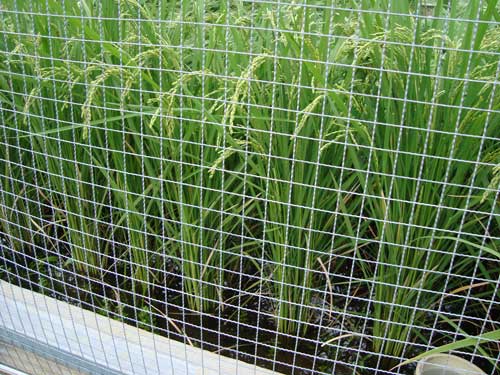
タヌキさんは有名な武蔵野美術大学を訪れましたが、新しくてすてきな図書館で勉強する大学生は彼を無視しています。
And all the students in the fancy new library ignore him.
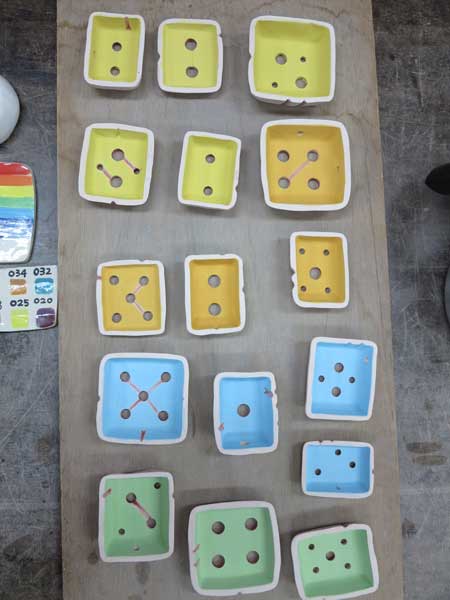
史火陶芸教室の展示会のために、カラフラな盆栽の植木鉢を作り終わるところです。エアープラントを中に入れる予定です。陶芸の先生も生徒さんも作品を見せて、販売します。西荻窪で、11月23日から27日まで。時間があれば、是非、見にきてください。
Above are some of the colorful bonsai pots for air plants that I am finishing for the Shiho ceramic studio annual show in Nishi-Ogikubo. It takes place just south of the JR station from Friday Nov 23 through Tuesday Nov 27. The teachers Yoshiko and Yoshiichiro Kuge will display and sell their works, as well as ten students and a doll maker.
As you can see in the card below, this year’s theme is spouts. Mine is the only spout full of holes. They provide drainage for after you’ve dunked the air plant in water.
Please come if you’re interested in ceramics! Gallery Hiko, 3-37-21 Shoan, Suginami-ku. Google Map.
Update: Tokyo Weekender featured this show in their events listings!



.@ilynam とユキさんと一緒に農大に来て、強い雨に降られました。入口に、「すくう人。環境学生』のポスターを見て、うれしくなりました。鈴木先生のために、海外に作られた日本庭園のことについて学べるサイトを作ります。デザインと庭と画像と土を一緒にするので、このプロジェクットは楽しいです。
It was raining when @ilynam and Yuki joined me for the first meeting to create a website for the 500 garden database of Japanese gardens outside Japan, a project I am helping Suzuki sensei with this year.
At the entrance to the school, somehow this rainy scene was an apt start for this exciting project where we will mix design, gardens, pixels, and soil. Bringing this knowledge online will be very helpful for people around the world who are interested in knowing about and visiting hundreds of Japanese gardens in dozens of countries. And working with design stars Ian and Yuki, I am confident that we can combine simplicity and beauty in the interface.
The banner offering campus tours for new students says, “We are people who scoop. Environmentally active students.” The word sukuu means “scoop” and also “save.”

この柿の木は史火陶芸教室の裏庭で育っています。二年に一回、果物がたくさん出来ますが、多くない年もたくさんとれます。毎年、義理の母が生徒さんや友だちに果物と果物で作った料理をあげます。秋は柿です。夏はユスラ梅です。東京は、果物の木が多いことを知っている外国人が少ないです。
Many foreigners are surprised just how full of persimmons Tokyo is in the fall. Maybe you’d miss them if you stick to inside the newest malls and corporate developments. But it must be one of the most popular residential trees, and a true marker of fall.
This one is behind Shiho ceramic studio, and the funny story is that my in law teachers say that this year there aren’t so many fruit. Despite being an off year in a two year cycle, there’s actually still quite a lot of fruit. My mother in law is a great cook, and she uses these fall persimmons and also small sour plums in summer for food she shares with students and friends. She didn’t plant these trees but has gotten a lot of use from them in the past ten years.
Some persimmon trees produce fruit that’s best eaten raw, others dried, or cooked into jam or other sweets. For me it’s an acquired taste, but seeing these orange globes dangling across Tokyo is undeniably beautiful.

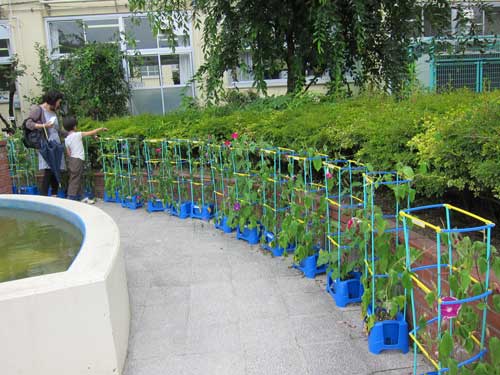
Last week’s election provided me the perfect pretext to check out the elementary school I always pass on the way to the train station. There was some minor confusion about why the foreigner was getting close to the polling station, but I was there just to observe.
Growing morning glories is a common elementary school project. I like how this semi-circle of trained vines is so organized and decorative. The flowers vary in color, and each plant is marked with the classroom that is providing care. I heard that the students track the progress in notebooks. Looks like fun.
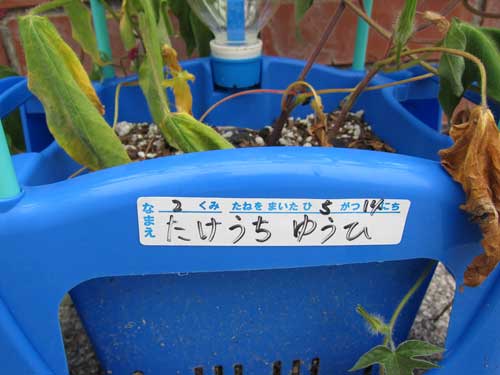
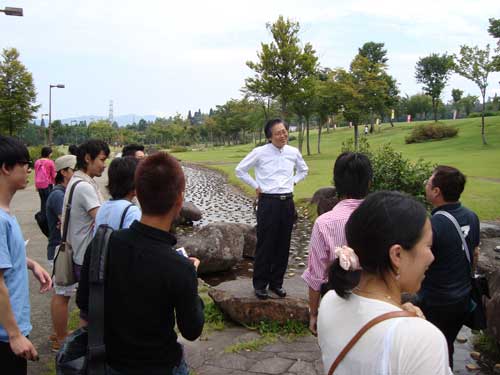
Frankly, arriving at New Greenpia (ニュー・グリーンピア) was a landscape and cultural shock after Obuse. Compared to the 600 year history of Obuse and multi-layered reinventions from the 1990s to the present, New Greenpia’s buildings and gardens reflect Japan’s famous Bubble from the 1980s. Amazingly, many of the Nodai students were born at the very end of the 1980s.
If I understood it correctly, it was a semi-public resort created to provide a place for working class urban people to experience nature. Sometime in the past five years, financial ruin led it to be sold to private owners, at a scandalously low price.
Next to a giant building that serves as conference center, hotel and event space, there are huge lawns leading to tennis courts and golfing. Between the building and the recreation area is a narrow river-themed landscape created by a Nodai professor over 20 years ago. The original design has water coming out of concrete cones, which is no longer functioning.
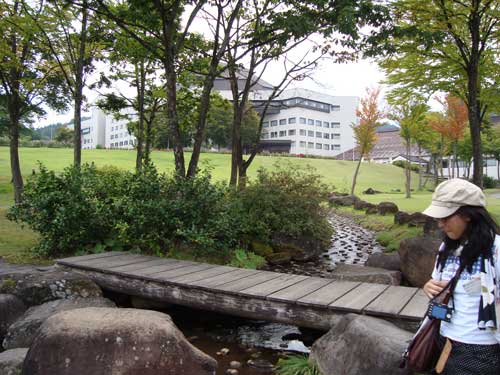
I realize that the built environment was created with good intentions. Still, the scale of the building and the large empty lawns do not take advantage of the natural surrounds. The garden river, too, seems a poor imitation of the surrounding abundance of natural streams and irrigated fields. And the lack of maintenance is a glaring testimony of the financial troubles Japan has encountered in the past 20 years. If anything, New Greenpia served as an educational transition between the seeming success of Obuse and the haunting abandonment we witnessed in Echigo, Niigata, the site of the Niigata Art Triennial, the subject of my next post.
Perhaps New Greenpia sees more activity during ski season. We saw a few go-carts racing down the snow-less slope. I will end this post with an unsettling image near the entrance to the building promoting weddings in sunflower fields (of which we saw no evidence). Maybe the giant photo ad is meant to suggest the contemporary relevance of nature for young yankii couples, possibly city residents. I wonder why all the guests are dressed in black.
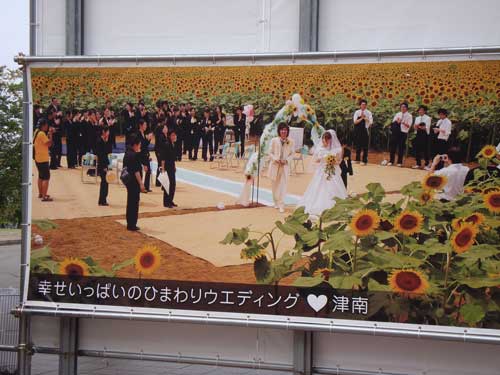
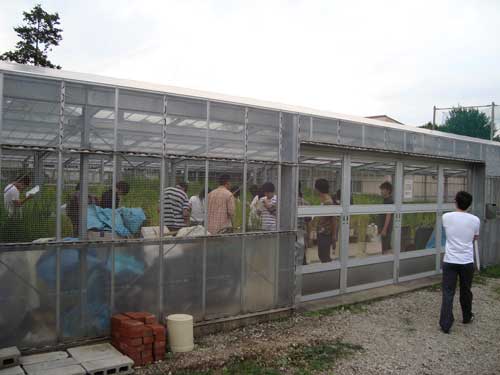
Watching students study rice in a field lab reminded me that, yes, I am really affiliated with an agricultural university in Japan. Nodai is the Tokyo University of Agriculture. The students were counting the number of rice stalks and the number of grains in each specimen. I wonder if the variables involved the plant, the growing medium or environment. The students looked very serious.
